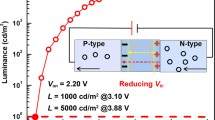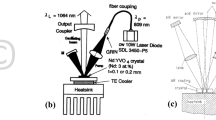Abstract
We experimentally investigate and analyze the electrical and optical characteristics of InGaAs/GaAs conventional quantum well laser diode and the quantum well laser diode with slightly-doped tunnel junction. It was found that the laser with slightly-doped tunnel junction has a nonlinear S-shape current-voltage characteristic. The internal quantum efficiencies of the laser with slightly-doped tunnel junction and the conventional laser are 21 and 87.3%, respectively. This suggests that the slightly-doped tunnel junction increased the barrier width and free carrier absorption, thus could reduce the electron tunneling probability and increase the internal loss. Furthermore, compared with the conventional laser, it was found that we could achieve 15 nm broadband spectrum from the laser with slightly-doped tunnel junction, due to the lasing dynamics reflecting the current dynamics. The results show that the slightly-doped tunnel junction plays a crucial role in the laser diode performances, which may lead to the realization of more applications.





Similar content being viewed by others
REFERENCES
L. Esaki, Phys. Rev. 109, 603 (1958).
J. P. van der Ziel and W. T. Tsang, Appl. Phys. Lett. 41, 499 (1982).
J. Yan, J. Cai, G. Ru, et al., in Proceedings of the Conference on Lasers and Electro-Optics, 2006.
J. Mi, H. Yu, H. Wang, et al., IEEE Photon. Technol. Lett. 27, 169 (2015).
M. Shirdel and M. A. Mansouri-Birjandi, Front. Optoelectron. 9 (4), 1 (2016).
F. Ricci, R. A. Rica, M. Spasenovic, et al., Nat. Commun. 8, 15141 (2017).
E. Yousefi and M. Hatami, Optik (Munich, Ger.) 125, 6637 (2014).
T. Mori, Y. Sato, and H. Kawaguchi, J. Lightwave Technol. 26, 2946 (2008).
S. O. Slipchenko, A. A. Podoskin, V. V. Vasil’eva, et al., Semiconductors 48, 697 (2014).
K. Hara, K. Kojima, K. Mitsunaga, et al., Opt. Lett. 15, 749 (1990).
W. K Chan and A. C. von Lehmen, US Patent No. 5132982 (1992).
F. R. Beyette, K. M. Geib, S. A. Feld, et al., IEEE Photon. Technol. Lett. 5, 686 (1993).
A. G. Kirk, H. Thienpont, A. Goulet, et al., IEEE Photon. Technol. Lett. 8, 464 (1996).
H. Wang, X. Zhou, H. Yu, et al., Appl. Phys. Lett. 104, 251101 (2014).
H. Wang, H. Yu, X. Zhou, et al., Appl. Phys. Lett. 105, 141101 (2014).
S. W. Wang, R. H. Wu, Q. G. Zhu, et al., Chin. J. Laser. 129, 306 (1980).
G. W. Taylor and H. Opper, IEEE J. Quantum Electron. 53 (3), 1 (2017).
H. Wang, J. Mi, X. Zhou, et al., Opt. Lett. 38, 4868 (2013).
L. A. Coldren and S. W. Corzine, Diode Lasers and Photonic Integrated Circuits (Wiley, Chichester, 1995).
S. O. Slipchenko, A. A. Podoskin, A. V. Rozhkov, et al., J. Appl. Phys. 116, 819 (2014).
J. Pan, L. Zhen, H. Wang, et al., in Proceedings of the International Conference on Optical Communications and Networks, 2015.
ACKNOWLEDGMENTS
We thank all the teachers and students in the PIC group of the Key Laboratory of Semiconductor Materials Science for their help.
The study was supported by the National Key Research and Development Program of China under grant no. 2017YFB0405301, and the National Natural Science Foundation of China under grant no. 61604144, grant no. 61504137.
Author information
Authors and Affiliations
Corresponding author
Additional information
The article is published in the original.
Rights and permissions
About this article
Cite this article
Yajie Li, Wang, P., Meng, F. et al. Investigation of InGaAs/GaAs Quantum Well Lasers with Slightly Doped Tunnel Junction. Semiconductors 52, 2017–2021 (2018). https://doi.org/10.1134/S1063782618160169
Published:
Issue Date:
DOI: https://doi.org/10.1134/S1063782618160169




